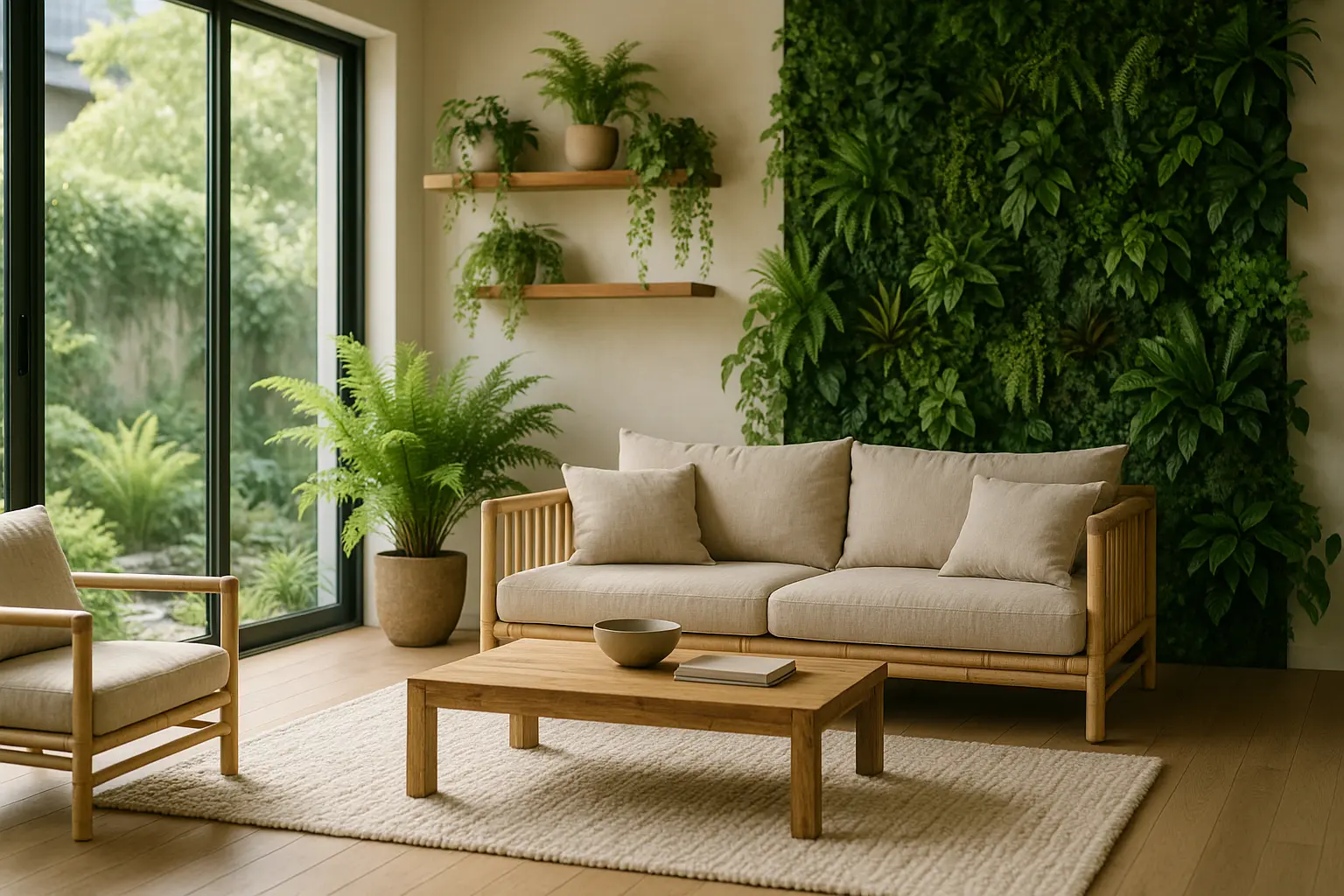In our rapidly urbanizing world, the distance between us and nature continues to grow. As we find ourselves surrounded by artificial environments, the craving for natural elements becomes palpable. Biophilic design emerges as a beacon, a movement striving to bridge this gap by seamlessly integrating the outdoors with our indoor spaces. This approach isn’t merely about aesthetics; it’s about fostering a harmonious connection with the natural environment. Today, we’ll delve deeper into this transformative design philosophy, uncovering its benefits and exploring ways to incorporate it into our living spaces.
Understanding Biophilic Design
Biophilic Design stems from the belief that humans possess an innate tendency to seek connections with nature and other forms of life. This concept, known as biophilia, has been gaining traction among designers and architects, reshaping the way we approach interior and exterior spaces. But why has this idea resonated so deeply?
Let’s visualize a typical urban environment: concrete jungles, glass structures, and a cacophony of artificial materials. While modern architecture celebrates innovation, it often leaves little room for natural elements. Here lies the contradiction: as much as we’ve advanced, we’ve distanced ourselves from what fundamentally nurtures our well-being.
Biophilic design offers a refreshing perspective. At its core, it encourages us to incorporate natural elements such as light, plants, and air into our spaces. By doing so, we create a more balanced environment that mirrors nature’s inherent serenity. Studies have shown that such spaces enhance productivity, reduce stress, and improve well-being.
When we think about biophilic design, it’s not just about adding a few plants here and there. It’s about creating a cohesive environment that respects the natural rhythms and patterns found in our world. By understanding this design ethos, we can embark on a journey to transform our living spaces into sanctuaries that resonate with life.
Incorporating Natural Elements into Indoor Spaces
Imagine stepping into a room that instantly evokes the feeling of a sunlit forest or a tranquil ocean view. This sense of peace can be achieved by thoughtfully incorporating natural elements into our indoor environments.
Light is one of the primary components. Utilizing natural lighting not only reduces energy consumption but also enhances our mood and cognitive functions. Large windows, strategically placed mirrors, and skylights can usher in abundant sunlight. For spaces where natural light is limited, using full-spectrum LED lighting that mimics daylight can be a viable substitute.
Then, there’s the undeniable allure of plants. They do more than just beautify a space; they actively improve air quality and create a sense of tranquility. From the humble succulent to the majestic fiddle leaf fig, plants can be tailored to any aesthetic and space requirement.
Incorporating natural materials like wood, stone, and bamboo adds a tactile richness to our spaces. These materials, with their unique textures and patterns, echo the diversity found in nature. Transform a room with wooden flooring, stone accent walls, or bamboo furniture to evoke a sense of groundedness.
Lastly, the inclusion of water elements—whether a small indoor fountain or an aquarium—can introduce a dynamic aspect to the environment, promoting relaxation and mindfulness. By ensuring a balance of these natural components, we can craft indoor settings that not only look beautiful but feel intrinsically connected to the outdoors.
Designing Outdoor Spaces with Biophilic Principles
Outdoor spaces offer limitless possibilities to immerse ourselves in the natural environment. While indoor spaces require careful integration of biophilic elements, the great outdoors demands a thoughtful design that harmonizes with nature’s inherent rhythm.
Begin with landscape design that embraces native plants and vegetation. Choosing local flora ensures sustainability and harmony with the natural climate. These plants thrive with minimal intervention, offering a vibrant landscape that requires less water and maintenance.
Pathways and seating areas should be crafted with enduring natural materials like stone or timber. These not only blend seamlessly with the environment but also invite tactile engagement, drawing us into a more intimate connection with our surroundings.
Incorporating water features—such as ponds, small waterfalls, or even rain gardens—can invigorate a landscape. The gentle movement of water introduces a soothing auditory dimension, alleviating stress and promoting mindfulness.
Lighting plays a crucial role in enhancing outdoor experiences, extending the time we can comfortably enjoy our spaces. Opt for soft, warm lights that mimic the setting sun, creating an inviting ambiance. Solar-powered lights offer an eco-friendly solution that complements the biophilic ethic.
Outdoor spaces are also perfect for multi-functional designs. Consider outdoor kitchens, meditation corners, or play areas that allow us to engage with nature in varied ways. Through biophilic design, we can create outdoor spaces that feel like an extension of our home, offering us endless opportunities to reconnect with the natural world.
Creating a Seamless Connection Between Indoors and Outdoors
The ultimate goal of biophilic design is to create a fluid transition between indoor and outdoor spaces. This seamless connection ensures that we constantly feel linked to the natural world, regardless of where we are.
One effective approach is the use of large glass doors or foldable walls that can be opened to merge spaces. When weather permits, this step can dissolve the boundaries between indoors and outdoors, allowing fresh air and natural vistas to permeate our living areas.
Patios and decks can serve as transitional spaces, blurring the line between the interior and the garden. By furnishing these areas with comfortable seating and soft textiles, they become inviting spots for relaxation and socialization.
Color palettes also play a crucial role. Using hues inspired by nature—such as earthy browns, soft greens, and ocean blues—can create a visual continuity throughout the space, reinforcing a sense of unity.
Lastly, the strategic placement of indoor plants near windows or open spaces can enhance this visual integration, drawing the eye outward and ensuring that the green of the garden feels like a natural extension of the indoor space.
By mindfully designing areas to embrace both worlds, we can create holistic environments that foster wellness, comfort, and a profound connection with nature. This approach invites life’s vibrant energies to flow freely through our homes, uniting us in spirit with the world beyond our walls.
In embracing biophilic design, we are not merely following a design trend; we are reconnecting with our roots, celebrating the intrinsic bond humans share with nature. By thoughtfully integrating natural elements into our environments, we cultivate spaces that nourish the body, mind, and spirit.
The journey towards a harmonious balance of indoor and outdoor spaces is both fulfilling and transformative. As we craft these environments, we are reminded of the beauty and serenity that the natural world offers and the profound impact it can have on our well-being.
Let us embark on this design revolution, where every space becomes a sanctuary that resonates with the timeless rhythms of nature. Together, we can create a world where the boundaries between humans and nature dissolve, empowering us to live our lives to the fullest, intertwined with the earth’s infinite abundance.
FAQ
What is biophilic design and why is it important?
Biophilic design is an approach that seeks to connect building occupants more closely to nature. It is essential as it promotes well-being, enhances creativity, and can improve productivity by integrating natural elements such as plants, natural light, and organic materials into the built environment.
How can I incorporate biophilic elements into my home?
Start by bringing in indoor plants, using natural materials like wood and stone, and maximizing natural light. Consider using earthy color palettes and installing water features or nature-inspired art to create a calming and inviting atmosphere.
What are some benefits of incorporating biophilic design in workplaces?
Incorporating biophilic design in workplaces can lead to reduced stress levels, increased employee satisfaction, improved concentration, and overall better mental health, resulting in a more productive and harmonious work environment.
Are there any specific outdoor biophilic design strategies I can apply in my garden?
Yes, creating diverse habitats like a butterfly garden, incorporating water features such as ponds, using native plant species, and designing spaces for relaxation and reflection are excellent strategies to enhance the biophilic experience outdoors.
Can biophilic design principles be applied in urban settings?
Absolutely. Urban environments can benefit from biophilic design through green roofs, vertical gardens, and the integration of green public spaces. These elements help mitigate urban heat, improve air quality, and provide city dwellers with a connection to nature.



